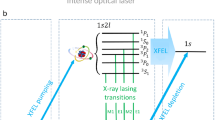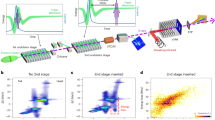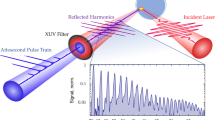Abstract
We present a new method for parametric amplification of soft-X-ray radiation. The laser-driven amplifier is based on parametric stimulated emission and is seeded with high-order-harmonic radiation generated in the same medium. The exponential increase of the soft-X-ray yield with increasing atomic density is experimentally demonstrated for two different sets of laser parameters. A small-signal gain up to 8×103 is obtained in both experiments at about 40 eV in argon using 350-fs-long laser pulses and with 6-fs-long ones at about 260 eV in helium, respectively. This new scheme reduces the pumping threshold for lasing with a comparable conversion efficiency into the millijoule level, which is about two orders of magnitude smaller compared with the conventional plasma X-ray lasers. With a simple model, we can estimate the necessary experimental conditions for identifying the spectral range and the magnitude of the maximum gain, which are in reasonable agreement with our measurements.
This is a preview of subscription content, access via your institution
Access options
Subscribe to this journal
Receive 12 print issues and online access
$209.00 per year
only $17.42 per issue
Buy this article
- Purchase on Springer Link
- Instant access to full article PDF
Prices may be subject to local taxes which are calculated during checkout




Similar content being viewed by others
References
Ewald, G. et al. Nuclear charge radii of 8,9Li determined by laser spectroscopy. Phys. Rev. Lett. 93, 113002 (2004).
Sanchez, R. et al. Nuclear charge radii of 9,11Li: The influence of halo neutrons. Phys. Rev. Lett. 96, 033002 (2006).
Seres, E. & Spielmann, C. Ultrafast soft X-ray absorption spectroscopy with sub-20-fs resolution. Appl. Phys. Lett. 91, 121919 (2007).
Seres, E. & Spielmann, C. Time-resolved optical pump X-ray absorption probe spectroscopy in the range up to 1 keV with 20 fs resolution. J. Mod. Opt. 55, 2643–2651 (2008).
Gumberidze, A. et al. X-ray spectroscopy of highly-charged heavy ions at FAIR. NIM B 267, 248–250 (2009).
Rus, B. et al. Multimillijoule, highly coherent X-ray laser at 21 nm operating in deep saturation through double-pass amplification. Phys. Rev. A 66, 063806 (2002).
Zeitoun, Ph. et al. A high-intensity highly coherent soft X-ray femtosecond laser seeded by a high harmonic beam. Nature 431, 426–429 (2004).
Wang, Y. et al. Phase-coherent, injection-seeded, table-top soft-X-ray lasers at 18.9 nm and 13.9 nm. Nature Photon. 2, 94–98 (2008).
Hasegawa, N. et al. Frequency filter of seed X-ray by use of X-ray laser medium: Toward the generation of the temporally coherent X-ray laser. Jpn. J. Appl. Phys. 48, 012503 (2009).
Matthews, D. et al. X-ray laser research at the Lawrence Livermore National Laboratory Nova laser facility. J. Opt. Soc. Am. B 4, 575–587 (1987).
Kato, Y. et al. Observation of gain at 54.2 Å on Balmer–alpha transition of hydrogenic sodium. Appl. Phys. B 50, 247–256 (1990).
Dunn, J. et al. Gain saturation regime for laser-driven tabletop, transient Ni-like ion X-ray lasers. Phys. Rev. Lett. 84, 4834–4837 (2000).
Kapteyn, H. C., Lee, R. W. & Falcone, R. W. Observation of a short-wavelength laser pumped by auger decay. Phys. Rev. Lett. 57, 2939–2942 (1986).
Präg, A. R., Glinz, A., Balmer, J. E., Li, Y. & Fill, E. E. Prepulse dependence of J=0−1 lasing at 32.6 nm in neon-like titanium. Appl. Phys. B 63, 113–116 (1996).
Nagata, Y. et al. Soft-X-ray amplification of the Lyman-α transition by optical-field-induced ionization. Phys. Rev. Lett. 71, 3774–3777 (1993).
Zimmer, D. et al. An improved double-pulse non-normal incidence pumping geometry for transient collisionally excited soft X-ray lasers. Opt. Express 16, 10398–10403 (2008).
Heinbuch, S., Grisham, M., Martz, D. & Rocca, J. J. Demonstration of a desk-top size high repetition rate soft X-ray laser. Opt. Express 13, 4050–4055 (2005).
Hudis, E., Shkolnikov, P. L. & Kaplan, A. E. X-ray stimulated Raman scattering in Li and He. Appl. Phys. Lett. 64, 818–820 (1994).
Fill, E. E., van Enk, S. J., Zhang, J. & Lambropoulos, P. Stimulated Raman scattering in helium with soft-X-ray laser radiation. Phys. Rev. A 54, 5374–5377 (1996).
Meyer, S., Chichkov, B. N. & Wellegehausen, B. High-order parametric amplifiers. J. Opt. Soc. Am. B 16, 1587–1591 (1999).
Winterfeldt, C., Spielmann, C. & Gerber, G. Control of high harmonic generation. Rev. Mod. Phys. 80, 117–140 (2008).
Elouga Bom, L. B., Ganeev, R. A., Abdul-Hadi, J., Vidal, F. & Ozaki, T. Intense multimicrojoule high-order harmonics generated from neutral atoms of In2O3 nanoparticles. Appl. Phys. Lett. 94, 111108 (2009).
Seres, J. et al. Source of coherent kiloelectronvolt X-rays. Nature 433, 596 (2005).
Seres, E., Seres, J. & Spielmann, C. X-ray absorption spectroscopy in the keV range with laser generated high harmonic radiation. Appl. Phys. Lett. 89, 181919 (2006).
Takahashi, E. J., Kanai, T., Ishikawa, K. L., Nabekawa, Y. & Midorikawa, K. Dramatic enhancement of high-order harmonic generation. Phys. Rev. Lett. 99, 053904 (2007).
Ravasio, A. et al. Single-shot diffractive imaging with a table-top femtosecond soft X-ray laser-harmonics source. Phys. Rev. Lett. 103, 028104 (2009).
Hergott, J-F. et al. Extreme-ultraviolet high-order harmonic pulses in the microjoule range. Phys. Rev. A 66, 021801(R) (2002).
Zhang, X. et al. Quasi-phase-matching and quantum-path control of high-harmonic generation using counterpropagating light. Nature Phys. 3, 270–275 (2007).
Seres, J. et al. Coherent superposition of laser-driven soft-X-ray harmonics from successive sources. Nature Phys. 3, 878–883 (2007).
Zepf, M., Dromey, B., Landreman, M., Foster, P. & Hooker, S. M. Bright quasi-phase-matched soft-X-ray harmonic radiation from argon ions. Phys. Rev. Lett. 99, 143901 (2007).
Kim, I. J. et al. Generation of submicrojoule high harmonics using a long gas jet in a two-colour laser field. Appl. Phys. Lett. 92, 021125 (2008).
Nomura, Y. et al. Attosecond phase locking of harmonics emitted from laser-produced plasmas. Nature Phys. 5, 124–128 (2009).
Balcou, P. et al. High-order-harmonic generation: Towards laser-induced phase-matching control and relativistic effects. Appl. Phys. B 74, 509–515 (2002).
Hopf, F. A., Meystre, P., Scully, M. O. & Louisell, W. H. Classical theory of a free-electron laser. Opt. Commun. 18, 413–416 (1976).
Lewenstein, M., Balcou, Ph., Ivanov, M. Yu., L’Huillier, A. & Corcum, P. B. Theory of high-harmonic generation by low-frequency laser field. Phys. Rev. A 49, 2117–2132 (1994).
Brabec, T. & Krausz, F. Intense few-cycle laser fields: Frontiers of nonlinear optics. Rev. Mod. Phys. 72, 545–591 (2000).
Gaarde, M. B., Schafer, K. J., Heinrich, A., Biegert, J. & Keller, U. Large enhancement of macroscopic yield in attosecond pulse train-assisted harmonic generation. Phys. Rev. A 72, 013411 (2005).
Parker, J. S., Armstrong, G. S. J., Boca, M. & Taylor, K. T. From the UV to the static-field limit: Rates and scaling laws of intense-field ionization of helium. J. Phys. B 42, 134011 (2009).
Misoguti, L., Christov, I. P., Backus, S., Murnane, M. M. & Kapteyn, H. C. Nonlinear wave-mixing processes in the extreme ultraviolet. Phys. Rev. A 72, 063803 (2005).
Bauer, D. & Mulser, P. Exact field ionization rates in the barrier-suppression regime from numerical time-dependent Schrodinger-equation calculations. Phys. Rev. A 59, 569–577 (1999).
Kuehl, T. et al. Optimization of the non-normal incidence, transient pumped plasma X-ray laser for laser spectroscopy and plasma diagnostics at the facility for antiproton and ion research (FAIR). Laser Particle Beams 25, 93–97 (2007).
Marowsky, G. Gain-narrowing studies with an organic dye laser. J. Appl. Phys. 45, 2621–2623 (1974).
Seres, J. et al. Sub-10-fs, terawatt-scale Ti:sapphire laser system. Opt. Lett. 28, 1832–1834 (2003).
Acknowledgements
This study has been sponsored by the Austrian Science Fund (grants No. F016 P03), the DFG grant TR18 P10, SE 1911/1-1, and TKM grants B154-09030 and B 715-08008. E.S. acknowledges support from the FSU grant ‘ProChance 2009 A1’. The authors acknowledge access to the laser system provided by the Institute of Photonics, Vienna University of Technology and the PHELIX laser team at GSI Darmstadt.
Author information
Authors and Affiliations
Contributions
J.S., T.K. and C.S. designed the experiments and wrote the manuscript; J.S. and E.S. carried out the soft-X-ray experiments in Vienna; J.S., D.H., B.E., D.Z. and V.B. carried out the XUV experiments in Darmstadt; J.S. supported the theory. All authors analysed the data and contributed to the completion of the manuscript.
Corresponding author
Ethics declarations
Competing interests
The authors declare no competing financial interests.
Supplementary information
Supplementary Information
Supplementary Information (PDF 847 kb)
Rights and permissions
About this article
Cite this article
Seres, J., Seres, E., Hochhaus, D. et al. Laser-driven amplification of soft X-rays by parametric stimulated emission in neutral gases. Nature Phys 6, 455–461 (2010). https://doi.org/10.1038/nphys1638
Received:
Accepted:
Published:
Issue Date:
DOI: https://doi.org/10.1038/nphys1638
This article is cited by
-
Perturbative optical parametric amplification in the extreme ultraviolet
Nature Communications (2015)
-
High-harmonic generation and parametric amplification in the soft X-rays from extended electron trajectories
Scientific Reports (2014)
-
Parametric amplification of attosecond pulse trains at 11 nm
Scientific Reports (2014)
-
Enhanced soft X-ray emission from carbon nanofibers irradiated with ultra-short laser pulses
Applied Physics B (2011)
-
Unexpected gain
Nature Physics (2010)



